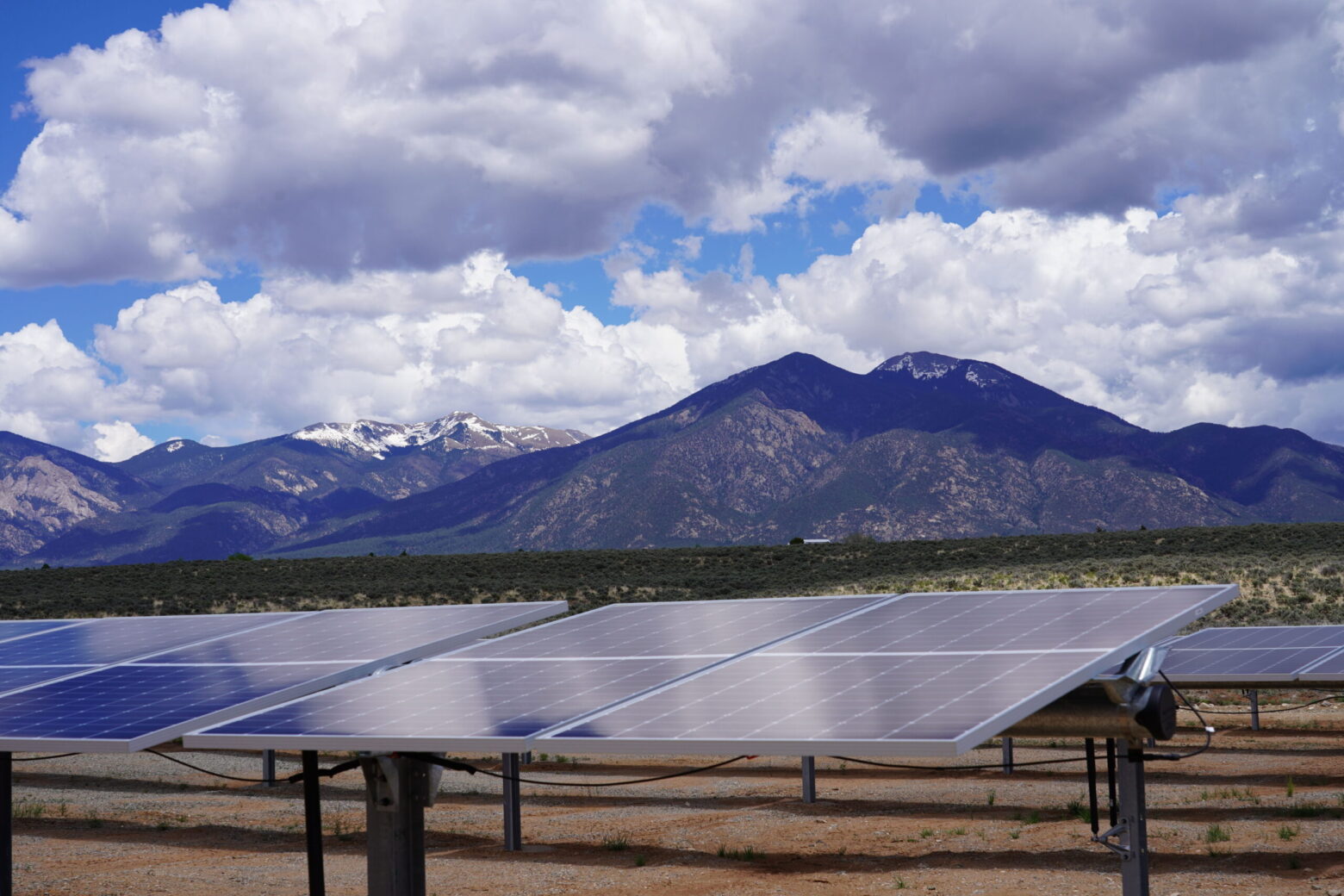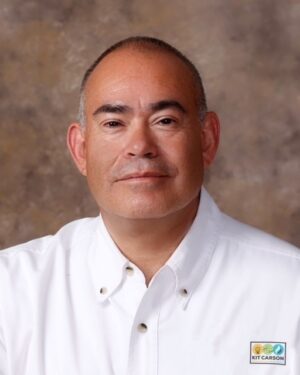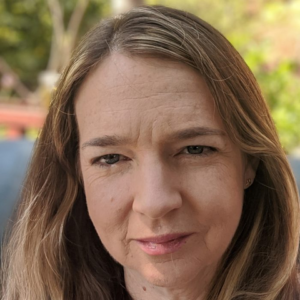
It started on a radio show. A listener asked Luis Reyes, CEO and general manager of Kit Carson Electric Cooperative, why Kit Carson had committed to a 40-year power supply contract when change was happening so fast in energy.
Reyes thought, Yes, why?
That launched a metamorphosis of the Northern New Mexico cooperative into what some see as the future of independent community energy.
Eight years after striking a deal to exit a 40-year fossil-fuel heavy supply contract, Kit Carson’s daytime solar output exceeds its demand. The co-op has reduced its retail and wholesale rates. And it is helping tribal communities do what most utilities resist — leave the system to achieve energy independence. More than that, the cooperative is looking to become self-sustaining, making it a utility able to operate for some time without a connection to the larger grid.
“They are leading the charge on transitioning to a more local grid model and have been really innovative in their approach — how they think about everything from the economic model to the local system impacts of the resources that are being added,” said Astrid Atkinson, CEO of Camus Energy, a software company that works with Kit Carson.
So how did this small Taos, New Mexico co-op, with only about 30,000 customers, far from the energy innovation meccas of California and New York, achieve this? And can others do the same?
Getting out of the supply contract

In a recent conversation I had with Reyes, he emphasized that the first step is finding out what community members want and trying to achieve it for them rather than making top-down decisions. His philosophy is that the community should dictate what power it consumes and not be subject to opaque contracts with outsiders.
The co-op’s quest for 100% daytime solar supply came from a listening tour with its members. Its 40-year contract with Tri-State Generation and Transmission made the solar goal impossible because it had prohibited Kit Carson from generating more than 5% of its consumption independently.
But getting out of the contract was no simple task. Like other generation and transmission suppliers, Tri-State depends on the participation of multiple utilities to garner favorable pricing based on scale. So departure is discouraged and, at that time, was rare.
Kit Carson was able to extract itself in 2016 after agreeing to pay Tri-State $37 million, which, in essence, spared other Tri-Gen buyers from taking on Kit Carson’s portion of the debt. The result, Reyes said, was an amicable parting of ways.
The dog that caught the bus
The next challenge was to find a new supplier, a big leap for Kit Carson because it had purchased power through a wholesale cooperative since its founding in 1944.
“Getting a power supplier that cared about our members and our mission to get more renewables — that was difficult. We were the dog that caught the bus, and now what do we do with it?’” he said.
Following a competitive solicitation, the co-op signed a 10-year wholesale supply contract with Guzman Renewable Energy, an affiliate of Florida-based Guzman Energy Group, which promised $50 million in savings. The new power supplier also had to agree to meet with co-op members.
Kit Carson has since signed a 15-year extension with Guzman, expected to provide wholesale savings of $150-170 million with 60% of its retail load served by renewables. According to Reyes, the timing of the contracts, combined with Guzman’s eagerness to make the deal work, has helped keep costs down.
Partnering with customers on distributed solar
However, the wholesale power supply contract was only half of the equation. Reyes grew up in the area and wanted clean energy to create jobs and a sense of community pride and ownership. So Kit Carson turned its attention to building locally sited, distributed energy. It started approaching cities, tribes, schools and others, inviting them to partner with the co-op to build solar on their premises under various contractual structures, including power purchase agreements, leases and co-op ownership models.
“Lo and behold, all of a sudden, we had people coming out of the woodwork,” Reyes said.
By July 2022, the community had 20 new solar facilities of various sizes, and the co-op had reached its goal of 100% daytime solar. Now, with 44 MW of solar, 60 MW of energy storage, and a daytime peak of 25-40 MW, Kit Carson has exceeded that goal, and solar is providing 120% of demand.
“So now everybody has solar. We brought equity to the playing field. It’s not just people who qualify for community solar or who have the means for rooftop solar,” Reyes said.
In doing so, Kit Carson also focused on building the local economy. For example, it hired local solar installers to help them scale their operations. Reyes has also been happy to see local ski attractions, manufacturers, and other businesses market their products as made from green energy.
Enter fiber optics and software orchestration
In addition to electricity, Kit Carson provides broadband and in 2022 won a $23,624,986 grant from the United States Department of Agriculture to expand the system.
With 3,000 miles of fiber optic cable, and an energy orchestration platform by Camus Energy that provides system visibility and resource management, Kit Carson is looking for ways to bring greater sophistication to its electric system.
Recently, the co-op has been pushing to overcome the divide between behind-the-meter and front-of-the-meter resources to improve electric reliability. Reyes testified on behalf of a state bill that would open the way for municipalities to put batteries or solar behind the meter. Reyes envisions Kit Carson installing batteries at critical facilities like wastewater treatment plants or cell towers. The co-op would manage them to serve the system except when the batteries are needed for reliability by the host.
“I’m really looking at how to enable Kit Carson to work on both sides of the meter and use the power when we need it, which is generally going to be at nighttime, and then allow the entity to use it when they need it,” he said.
What’s next?
Reyes ticks off a series of other aspirations.
Kit Carson wants to achieve 80% renewable energy around the clock by 2030 and eventually be able to separate its system from the central grid and operate independently when it’s advantageous. In addition, it is testing selling its excess energy into California’s energy imbalance market to generate revenue. And it’s exploring creating green hydrogen using wastewater or reclaimed water. The hydrogen would provide long-duration storage via fuel cells.
The co-op considered forming virtual power plants but faces regulatory roadblocks in New Mexico. Reyes said he’s tried raising the subject with state lawmakers, but “they have no clue what I’m talking about.” State restrictions also halted the co-op’s flirtation with peer-to-peer energy transactions among customers.
Is Kit Carson’s model scalable?
Kit Carson may have a leg up in creating community energy because of its business model. It is a cooperative, not an investor-owned utility.

Camus Energy’s Atkinson pointed out that co-ops are member-owned and governed by member-elected boards, so they see themselves as a community entity and tend to act more quickly on local requests. Co-ops are also non-profit, she said, and do not want to spend more money on energy or grid expansion than is necessary.
“The investor-owned utilities have more mixed motivations on that front. They, in general, make a profit off their regulated rate of return on capital investment. And their cost of energy is a pass-through,” she said.
Investor-owned utilities do care about keeping rates affordable, Atkinson added, but “it’s not the same thing as having community members coming into your office to say, ‘Look, my bill is $20 higher this month than usual. Why is that? It’s really hard for me to afford it.’”
Reyes said he gets inquiries about the co-op’s work from many places, including urban areas. And he thinks even they can model the Kit Carson approach — or at least pieces of it — to bring about community energy. That’s his hope.
“We’ve created — without legislation or all this kind of nonsense sometimes that goes in Washington — a green economy. We’ve created jobs, created opportunities, and we have power that works,” Reyes said.
